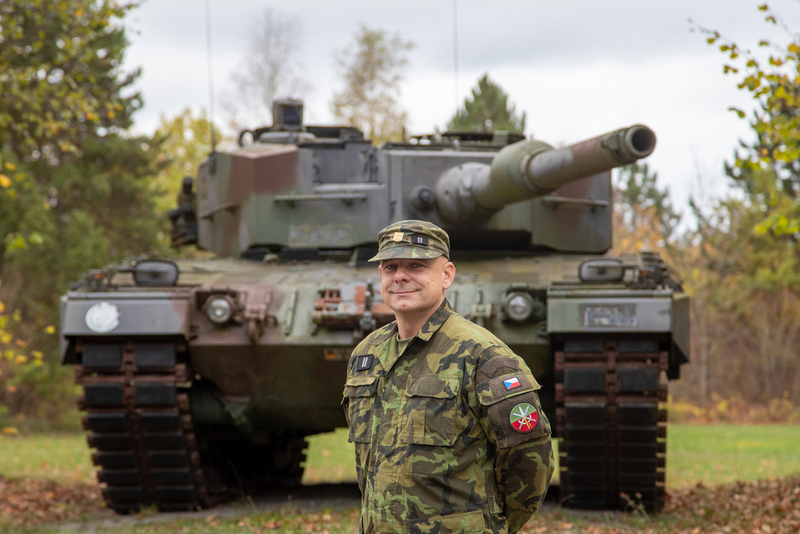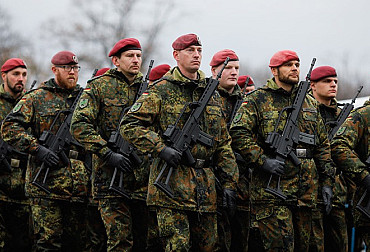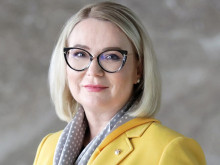Gen. Zdeněk Mikula: The times when the 7th Mechanized Brigade was pejoratively called Cinderella due to its weaponry are long past
The 7th Mechanised Brigade, which is armed with tanks and infantry fighting vehicles, is to be fully combat capable by January 2026, according to the Czech Republic’s commitment to NATO, and is thus due for a massive modernisation in the coming years. We asked Brigadier General Zdeněk Mikula, who has been its commander since 1 August, for an interview about the current state and future of our heavy brigade.

Picture: Brigadier General Zdeněk Mikula | Ministry of Defence of the Czech Republic
The 7th Mechanised Brigade is often referred to as "forgotten" in connection with its modernisation. Do you think that better years are finally ahead for the "7th", now that the acquisition of new CV90 MkIV IFVs and tanks is being discussed?
The times when the 7th Mechanised Brigade was pejoratively called Cinderella because of its weaponry are long gone. The rearmament with new tracked infantry fighting vehicles (IFVs) is the most important step for us in terms of increasing combat capabilities, but in a way it is almost the final step. We have already undergone a major change in the past few years in terms of upgrading weapons, equipment and materials. It is primarily about the armament and equipment of the soldier himself. At the moment we have a completely re-equipped brigade to NATO calibre. This is true both for the "long gun", where we are already moving to the next generation of BREN assault rifles, and for the "short gun" where the already established PHANTOM pistol is gradually being replaced by the new P-10 type. The brigade has also introduced new precision rifles and MINIMI machine guns. As regards soldier protection, new ballistic helmets have been delivered to the brigade and the delivery of ballistic vests is being completed. I am proud to say that the equipment and armament in question already corresponds to the soldier of the 21st century.
In terms of combat equipment, we are awaiting the delivery of the Leopard 2 A4 tanks donated to Germany, which will be followed by the delivery of the new main battle tank (MBT). We will only be able to bridge the period until the delivery of the new MBTs thanks to the ongoing technical evaluation of the current T-72 M4CZ tanks. Thanks to the substantial progress in the tender for the IFV procurement since the beginning of this year, I believe that the contract will be signed as soon as possible, and the CV90 MkIV will become, together with the new MBT, the backbone combat platform of the 7th Mechanised Brigade.
How long is the brigade able to maintain the BVP-2 in a state of capability for eventual operational deployment and in what numbers? Will these vehicles be able to perform their function until the arrival of the new equipment?
In my opinion, the BVP-2 is long past its sell-by date, morally and technically obsolete, and certainly not 21st century equipment. We are, of course, ready to use the BVP-2 until its replacement, including its planned deployment as part of the international battalion group in Slovakia in response to Russian aggression. But the turn of 2025 and 2026 is really critical for us. This is the real end of our ability to keep this equipment combat capable and to continue to operate it under current conditions. The fact that the BVP-2 is still operational is a huge credit to our technical staff and drivers, who spend a disproportionate amount of time on maintenance.
In the context of the planned acquisition of Swedish CV90 MkIV IFVs for the Czech Republic and Slovakia, there is talk of mutual cooperation. Slovakia, however, is asking for a 35 mm cannon as opposed to the Czech Republic, which is asking for a 30 mm cannon. What opportunities or advantages do you see for the cannons of the mentioned calibers?
This question is primarily for the Force Development Section of the MoD. The CV90 vehicle is already in the armament of several European armies, where it is used with 30 mm, 35 mm and 40 mm calibre cannons. As always, there are a number of advantages and disadvantages of both calibers that can be considered from many perspectives. As future users we are fully involved in the specification process and the requirement of the Army is based on a comprehensive evaluation.
 Picture: The 7th MB will probably be equipped with the Swedish CV90 MkIV infantry fighting vehicle as part of the modernization | BAE Systems
Picture: The 7th MB will probably be equipped with the Swedish CV90 MkIV infantry fighting vehicle as part of the modernization | BAE Systems
The 7th Mechanised Brigade is not only about the IFVs, but also about other equipment. In your opinion, how promising are the prospects for modernising the rest of the 7th Mechanised Brigade's fleet?
The ground equipment fleet has been renewed, especially on the platform of the well-known TATRA brand. There has been a partial modernisation of PRAM towed mortars. New vehicles were delivered for these mortars, which was a necessary step to be able to use these mortars until the new self-propelled mortars are delivered.
 Picture: TATRA 815-7 PRAM is used to transport the M. 82 PRAM-L mortar, its crew, ammunition and material | Jan Juřica / CZ DEFENCE
Picture: TATRA 815-7 PRAM is used to transport the M. 82 PRAM-L mortar, its crew, ammunition and material | Jan Juřica / CZ DEFENCE
Probably everyone has noticed the new Toyota Hilux vehicles, which at the 7th mb definitely ended the era of UAZ vehicles. By the end of this year, we expect to start deliveries of the new Iveco chassis-based S-LOV CBRN and CBRN II pairs, which will replace the old "chemical" UAZs and BRDMs.
In the second half of this year, the 7th MB conducted military trials of TITUS wheeled armoured vehicles, in the command and staff, liaison and fire support coordination site versions. This is the key equipment that will be delivered to the brigade and other units of the Czech Armed Forces supporting the Brigade Task Force (BTF) from next year.
 Picture: Deliveries of new S-LOV CBRN and CBRN II pairs on Iveco chassis are expected to start by the end of this year | Michal Pivoňka / CZ DEFENCE
Picture: Deliveries of new S-LOV CBRN and CBRN II pairs on Iveco chassis are expected to start by the end of this year | Michal Pivoňka / CZ DEFENCE
If we talk about a brigade as it is understood in NATO, it is a BTF (Brigade Task Force) in the terms of the Czech Army. Thus, the combat units of the 7th Mechanised Brigade are supplemented with combat support and combat support elements from the individual components of the Czech Army (Land Forces, Air Forces, Military Health Agency of the Czech Armed Forces) and Military Police. In this context, I perceive very positively the acquisition of new CAESAR self-propelled howitzers together with the fire control system, which will result in a substantial increase in the fire support capability of the BTF.
 Picture: In the second half of this year, the 7th MB conducted military trials of TITUS wheeled armoured vehicles | Dan Potocký
Picture: In the second half of this year, the 7th MB conducted military trials of TITUS wheeled armoured vehicles | Dan Potocký
Speaking of tanks, how many new tanks do you think the 73rd Tank Battalion would need in order to have sufficient combat capability and to fulfil its commitments to the Alliance?
This is again a question for the Force Development Section of the MoD. Anyway, as far as the requirements for a heavy brigade are concerned, the current number of tanks is already below the critical minimum. This means that I see an increase in the current number of tanks as desirable and relevant.
The delivery of all Leopard 2 A4 tanks to the Czech Armed Forces should be completed by the end of 2023. How is the 73rd Tank Battalion preparing the "facilities" for the new equipment?
The construction of new garages for Leopard 2 A4 tanks and new MBTs will take place in parallel with the construction of new garages for IFVs. At the moment, preparation of the construction project is underway, when the project documentation will be prepared and then construction will take place. Leopard tanks will be parked in the existing covered stalls until construction is completed.
Will there be any change in the approach of, say, service personnel?
Yes. One of the benefits of this donation is that we are getting a Western-type tank, which is close to NATO standards, both in terms of calibre and design. We welcome this fact, because one of the biggest pitfalls of introducing new equipment is "cultural" resistance. Soldiers are 'fixated' on a certain type of equipment that accompanies them throughout their professional lives. Change always brings certain friction points. So now we have an opportunity to change these cultural "patterning" and Soldiers have a unique opportunity to learn about the design of this tank, its operation and maintenance principles. As part of our closer cooperation with the Bundeswehr, we also have the opportunity to introduce our command staff to the German way of using the Leopard 2 tanks. We can take inspiration from what they have done, or learn from mistakes that our German colleagues have made in implementing the new tanks alongside the new infantry fighting vehicles.
 Picture: Eight Czech Army tank drivers and technicians recently spent nearly a month on an initial retraining course for German Leopard tanks. | Bundeswehr
Picture: Eight Czech Army tank drivers and technicians recently spent nearly a month on an initial retraining course for German Leopard tanks. | Bundeswehr
Have there been any trainings, training sessions and what kind of trainings do you foresee in the future?
In October, an agreement was signed with the German side, which includes training and cooperation with the Bundeswehr. The training of tank crews is planned and the first driver's course in Munster, Germany, has already taken place at the end of October and the beginning of November. One more run will take place before the end of this year. Next year this cooperation will continue, either in Germany or afterwards using the mobile training team in the Práslavice garrison. Furthermore, we have established cooperation with the Austrian Armed Forces, who have many years of experience with this particular tank version and have a training base. A tank crew course divided into two phases is already underway here and will be completed by mid-December this year. The aim is to prepare our instructors and in the future to train crews and technical staff on our own, including the involvement of Training Command – Military Academy in Vyškov.
In connection with the delivery of Leopard tanks, the number of crew members will also change. Is the 7th Brigade already counting on increasing the numbers of loaders? Can you tell us how the original crews have regrouped?
Due to the number of tanks donated, they will be incorporated into the Active Reserve Company of the 73rd Tank Battalion. The core of the 73rd tpr will remain on T-72 M4CZ tanks until the rearmament to the new MBT. The entire tank battalion will be continuously retrained for individual positions within the Leopard tank crews. In other words, we will actually create a "pool" of specific capabilities that will be key to the transition to the new MBT.
However, it is likely that a model crew for the first tank types already exists. Right?
Yes, we have already defined the requirements for each tank crew member. Courses are underway to prepare the first complete crews to conduct abbreviated military tests. It is also important to note that some of the Leopard tank crew positions must be interchangeable. This means, for example, that the gunner must be interchangeable with the loader and vice versa. Just for the record, the charger position is now called operator due to its capabilities and the principles of job systemization.
How is the transport capacity of the 7th Mechanised Brigade in relation to the arrival of Leopard tanks? Are the current trailers capable of transporting these tanks?
No. However, this transport capacity will now be available to the 14th Logistic Support Regiment, which will transport Leopard tanks as required. Increasing the transport capability of the 73rd tpr will be part of a comprehensive solution to rearmament to the new MBT.
The 7th Mechanised Brigade consists mainly of high quality, well trained soldiers. What condition is the brigade in today in terms of personnel? On the basis of the declared major modernisation of the existing combat equipment, is there an increase in the number of people interested in serving with the brigade?
In terms of personnel, that is basically the best I could take over. The soldiers of the 7th Mechanised Brigade are really motivated and fulfil the vast majority of all qualification requirements and prerequisites, both linguistic and professional. Our soldiers are continuously taking a lot of courses in the Czech Republic and abroad to be prepared for their next positions both in the brigade and in other elements of the Czech Armed Forces. The professionalism of the soldiers is a foundation for me to build on.
I am aware that with the arrival of new tracked combat vehicles, the battalions will increase their numbers. The number of new combat vehicles is higher than the number of BVP-2s currently in use. We are moving to what is called a four-man platoon formation. This means that there are three BVP-2s on the platoon now, but there will be four CV90s in the new structure.
In the 7th mb's surrounding regions, there are still plenty of people interested in the service. Personally, I believe that the new, technologically advanced equipment can attract more people. At the same time, in cooperation with the Force Development Section, we are trying to increase the attractiveness of our garrisons in terms of facilities for soldiers.
What were your goals when you took over the 7th Mechanised Brigade?
When I took over the post, I was given two basic tasks by the Minister and the Chief of the General Staff, creating conditions for rearmament and retaining personnel.
Within the first task, my goal is to influence a change in mindset. With the acquisition of new equipment, we must also change the mindset of our commanders. The new vehicles will have qualitatively much higher capabilities, they will be equipped with battlefield information systems and information on positions and tactical situation. They will be able to use information from unmanned aerial vehicles or aircraft. Put simply, the commander's ability to see the battlefield in a much more comprehensive way will increase substantially. On the other hand, they will require more sophisticated diagnostics and maintenance. The commander must take all this into account in his planning and management.
In terms of personnel retention, I want to continue the trend set and further develop the attractiveness of the 7th Mechanised Brigade. For me, the key is the culture of the organisation, training and quality selection of key personnel, the so-called "talent management".
In your opinion, has the conflict in Ukraine changed the view on tactics in any way?
Quite significantly, and in a lot of areas. As an example, I would mention places of command. There is a big challenge ahead of us, which is to optimise them – to "slim them down" and increase their mobility, all while maintaining an adequate level of protection. In the conditions of real conflict, we see how it is literally vital to manoeuvre several times a day with different command posts and at different levels of command.
How do you integrate Active Reserve into the work of the brigade?
Active Reserves are a solid part of the brigade. AR soldiers have similar training to the professional soldiers, but in significantly more difficult and time-consuming conditions. They are trained on the same equipment and represent an irreplaceable component for us. In addition to supporting us in certain tasks for the benefit of the IRS or in dealing with calamity situations, they are indispensable in replenishing vacancies and combat losses. Personally, I also very much appreciate the fact that ARs have a primary civilian job in addition to their military profession. I truly see them as a full part of the brigade. This is evidenced by the fact that they will be part of the deployment of the International Battalion Task Force to Slovakia during the next year.
How does NATO view the inclusion of Active Reserve in our key 7th "Heavy" Brigade?
I think it is not unusual even within NATO countries. The professional army needs to have a wider opportunity to include other elements that do not want to or cannot be "full time" soldiers, but nevertheless understand their contribution to the defence of their own country. In the terms of the Czech Army, these are the Active Reserves.
Recently, there has been talk of the department actually acquiring what the Army asks for. Do you see more intensive support for the purchase of new equipment in the Ministry of Defence?
As far as the Land Forces, and more specifically the 7th MB, are concerned, we have been consistent in identifying the needs for a long time and we do not deviate fundamentally from the Concept for the Construction of the Armed Forces in our current requirements. What has fundamentally changed due to the security situation is the time aspect. And without the aforementioned support, we would not be able to fulfil the required capabilities in such a limited time.
Do you have the opportunity to compare the combat capability and the general state of our Army with the armies of other allied states? How does our army compare to other countries?
Although we still often operate with obsolete combat equipment, we are viewed very positively by allies in deployments. The performance of our soldiers is professional. Again, I come back to the essential point that having well-prepared personnel is simply key.
What is the prototype of the 21st century soldier? It's no longer just a man who knows the weapon and the drill.
We think hard about the future. We see the battlefield changing. We're talking about hybrid or multi-domain warfare. Increasingly, disruptive technologies and artificial intelligence are being introduced into the military. All of this is shaping our requirements for the 21st century soldier.

We are likely to see significantly different requirements for the future soldier depending on their specialisation. For example, the traditional infantryman, the so-called 'big man', will need to maintain a high level of physical fitness in order to negotiate a stretch of terrain or move in a built-up area with an ever-increasing workload. Although technologies already exist to support movement on the battlefield, several more generations of infantrymen will have to work on the training ground. On the other hand, we have more and more specializations where the key skill is to operate sophisticated equipment or to engage the enemy other than in direct contact. Here, other skills will be a priority.
We also need to be sensitive to how new generations are evolving culturally and socially. We simply cannot stop generational evolution. We must adapt, learn to communicate effectively. But that certainly doesn't mean compromising our requirements or standards, the goal is the same but the way we achieve it will be will have to change.





















